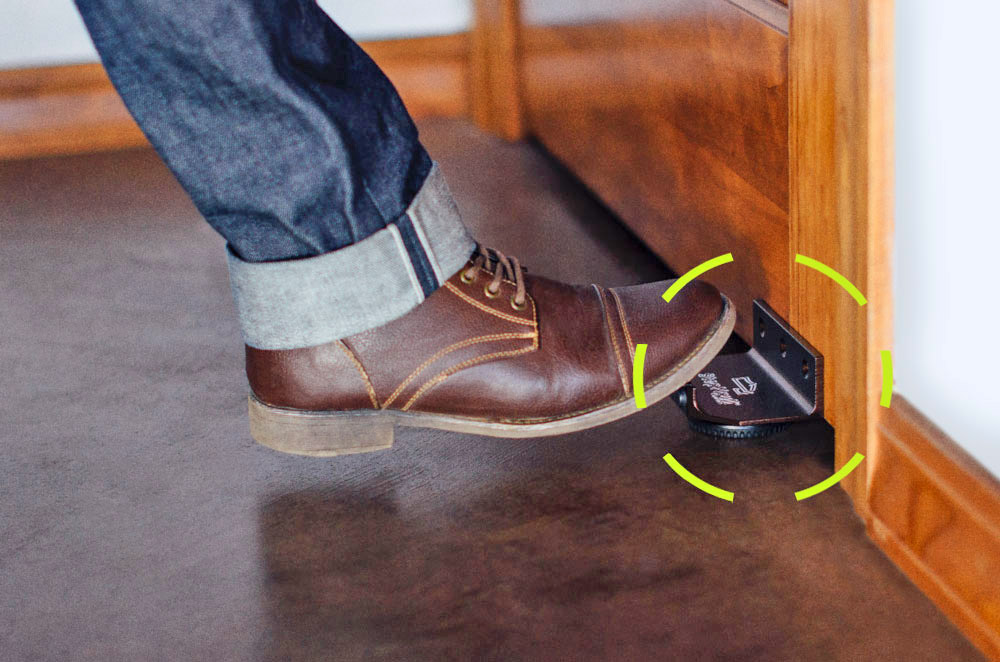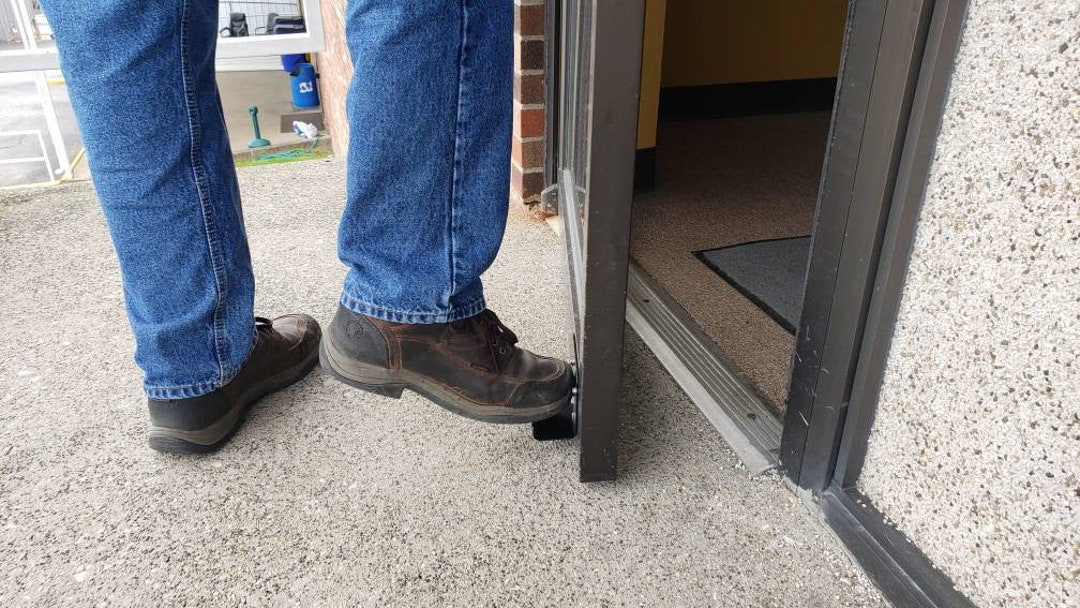Foot Pedal Bathroom Door Opener

Foot pedal bathroom door opener – In the realm of bathroom fixtures, the foot pedal door opener stands as a testament to innovation and accessibility. This ingenious device seamlessly integrates convenience and hygiene, offering a hands-free solution for opening bathroom doors.
Benefits of Foot Pedal Door Openers
Foot pedal door openers offer a multitude of benefits, particularly in bathroom settings where hygiene and accessibility are paramount.
Imagine a world where doors open with the mere touch of your foot, a world where hands are free to carry burdens, not keys. A foot pedal bathroom door opener embodies this vision, a simple yet revolutionary innovation. But what happens when the lock fails, and the door becomes a barrier instead of a passage?
Fear not, for help is at hand! Unlocking a bathroom door can be a straightforward process, a journey back to freedom. With a foot pedal opener, the door becomes a symbol of ease and accessibility, a testament to the power of innovation to enhance our lives.
- Enhanced Hygiene: By eliminating the need for manual door handles, foot pedal openers minimize the spread of germs and bacteria, creating a cleaner and healthier environment.
- Accessibility for All: These openers provide a convenient and accessible option for individuals with limited mobility, allowing them to easily open doors without assistance.
- Reduced Contact Points: Foot pedal door openers minimize contact points, reducing the risk of cross-contamination and promoting a more hygienic experience.
Types of Foot Pedal Door Openers
The market offers a diverse range of foot pedal door openers, each designed to cater to specific needs and preferences.
The foot pedal bathroom door opener, a simple innovation, speaks volumes about the delicate dance of privacy and accessibility. It’s a testament to the importance of considering those who might find traditional door handles challenging, while also acknowledging the age-old debate about leaving the bathroom door open.
Perhaps the foot pedal is a silent advocate for inclusivity, a gentle reminder that we can all benefit from a little more consideration, whether it’s in the bathroom or in life.
- Standard Foot Pedal Openers: These are the most common type, featuring a simple pedal mechanism that directly engages the door latch.
- Wireless Foot Pedal Openers: These openers utilize wireless technology, allowing for greater flexibility in installation and placement.
- Automatic Foot Pedal Openers: These advanced openers incorporate sensors that detect foot movement, automatically opening the door for a hands-free experience.
Installation and Usage: Foot Pedal Bathroom Door Opener

Installing and using a foot pedal bathroom door opener is a simple and straightforward process. This device provides a hands-free and hygienic way to open doors, especially in restrooms where maintaining cleanliness is crucial.
Installation Process
Installing a foot pedal door opener typically involves attaching the pedal to the floor and connecting it to the door’s opening mechanism. The specific steps may vary depending on the type of door and the chosen installation method.
Steps for Installation
- Determine the installation location: Choose a spot on the floor near the door where the pedal will be easily accessible with your foot and won’t obstruct foot traffic.
- Mark the installation location: Use a pencil or marker to mark the spot where the pedal will be mounted.
- Drill holes: Drill holes at the marked location according to the pedal’s mounting instructions. Ensure the holes are the correct size and depth for the provided screws.
- Attach the pedal: Secure the pedal to the floor using the provided screws and ensure it is firmly mounted.
- Connect the pedal to the door mechanism: Connect the pedal to the door’s opening mechanism, such as a hinge or latch, using the provided hardware or an appropriate connecting system.
- Test the installation: Once the pedal is installed, test it by stepping on it to open the door. Ensure the pedal operates smoothly and the door opens and closes properly.
Usage
Using a foot pedal door opener is simple and intuitive.
Operating the Foot Pedal Door Opener
- Approach the door: Walk towards the door with the pedal positioned near the entrance.
- Position your foot: Place your foot on the pedal, ensuring it is firmly positioned on the designated area.
- Apply pressure: Apply gentle pressure to the pedal with your foot. This will activate the door opening mechanism.
- Open the door: The door will swing open as the pedal activates the opening mechanism.
- Close the door: After passing through the door, allow it to swing closed automatically or gently push it shut with your foot or hand.
Installation Methods
Different installation methods are available for various door types, each with its advantages and considerations.
Installation Methods for Different Door Types
| Door Type | Installation Method | Advantages | Considerations |
|---|---|---|---|
| Swinging Doors | Direct Connection to Hinge | Simple and straightforward | May require adjustments to door hinge position |
| Sliding Doors | Lever Mechanism | Suitable for sliding doors | May require additional hardware for smooth operation |
| Pocket Doors | Cable or Rod System | Concealed installation | Requires proper cable or rod routing |
Benefits and Considerations

Foot pedal bathroom door openers offer a range of benefits, particularly in terms of accessibility and hygiene, while also presenting certain considerations for implementation.
Accessibility Benefits
Foot pedal door openers provide a valuable solution for individuals with disabilities who may face challenges using traditional door handles. These challenges can include:
- Limited hand mobility: Individuals with conditions such as arthritis, cerebral palsy, or spinal cord injuries may find it difficult to grasp and manipulate door handles.
- Reduced grip strength: Conditions like muscular dystrophy or stroke can affect grip strength, making it challenging to open doors.
- Sensory sensitivities: Some individuals may experience discomfort or aversion to touching surfaces due to sensory sensitivities, making foot pedal openers a more comfortable alternative.
By providing a hands-free mechanism, foot pedal door openers promote independence and accessibility for individuals with diverse abilities.
Impact on Hygiene and Infection Control, Foot pedal bathroom door opener
Foot pedal door openers play a crucial role in enhancing hygiene and infection control within bathroom environments. This is achieved by:
- Minimizing contact: By eliminating the need to touch door handles, foot pedals reduce the potential for cross-contamination. This is particularly important in high-traffic areas like public restrooms where multiple individuals may use the same door.
- Reducing the spread of germs: Door handles are frequently touched by individuals with potentially contaminated hands, contributing to the spread of germs. Foot pedals, on the other hand, are less likely to be touched by bare hands, reducing the risk of transmitting infections.
- Promoting a cleaner environment: Foot pedal door openers encourage better hygiene practices by providing a hands-free option. This can contribute to a cleaner and healthier bathroom environment overall.
In healthcare settings, where infection control is paramount, foot pedal door openers are widely recognized as an effective measure to minimize the spread of pathogens.
Cost-Effectiveness
The cost-effectiveness of foot pedal door openers compared to traditional door handles depends on several factors, including:
- Initial installation cost: Foot pedal door openers may have a higher initial installation cost compared to traditional door handles. However, this cost can be offset by long-term benefits.
- Maintenance costs: Foot pedal door openers generally require minimal maintenance, reducing long-term expenses.
- Reduced cleaning costs: The reduced need for frequent cleaning of door handles can contribute to cost savings in the long run.
- Increased longevity: Foot pedal door openers are typically more durable than traditional door handles, extending their lifespan and reducing replacement costs.
While the initial cost may be higher, the long-term benefits of reduced maintenance, cleaning, and replacement costs can make foot pedal door openers a cost-effective solution over time, particularly in high-traffic areas.